Matador Network's Blog, page 592
September 13, 2021
Some Virgin planes will soon have lounge booths for the chicest in-flight cocktail experience
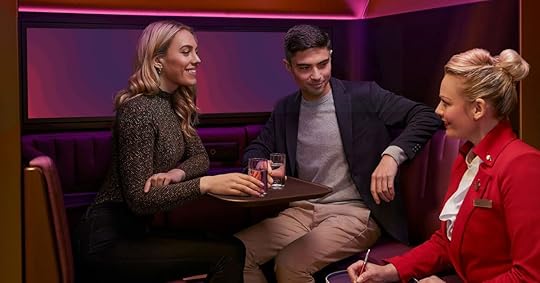
Anyone who has flown knows that the amenities in first class are quite enviable when compared to economy tickets. Now Virgin Airlines is taking first-class amenities to a whole new level that might make you want to splurge for the coveted seats. The airline, which is already known for its in-flight bar and loft area, recently announced a new interior and cabin configuration of the A350 aircraft that includes “The Booth,” which puts bar-like seating in the sky.
The Booth is built like the booth-seating you’d find at a restaurant or bar with leather seats and a table in the middle for two people. It also includes two 27-inch touch screen monitors to showcase a digital art gallery featuring up-and-coming artists and a camera with live footage of the aircraft making its way through the sky.
“We’re famous for our on-board social spaces and the introduction of The Booth elevates the customer proposition for our leisure travelers to new heights,” chief customer and operations officer Corneel Koster said in a press release. “We love creating brilliantly different experiences, which is why we’re always evolving our ideas to offer something different and exciting in the air and on the ground.”
The Booth will first be available to travelers in December 2021 who are traveling between London and Orlando, Florida, and it will roll out to A350 aircrafts to other sunny destinations like Barbados in 2022.
“I’m delighted that we’ve curated The Booth specifically for our customers jetting off on holiday to our sunny destinations, such as Orlando, offering a truly stylish start to their trips,” Koster said.
Other changes to the A350 aircraft include expanding its capacity to 397 seats — 16 upper class suites, 56 premium seats, and 325 economy seats. The Upper-Class suites will now have all window-facing seats with a fully flat bed, and all cabins now have the largest entertainment screens available on any Virgin Atlantic plane. 
The post Some Virgin planes will soon have lounge booths for the chicest in-flight cocktail experience appeared first on Matador Network.
This US road trip will take you to the best places to dig for gems

Gemstones are like safari animals. Most people covet the Big Five, or Big Four as is the case with precious stones: diamonds, rubies, emeralds, and sapphires. Some may be surprised to learn that all four of these gems can be found in the United States. Diamond mines, for example, conjure thoughts of South Africa quicker than Arkansas, yet just last year, Arkansas native Kevin Kinard uncovered a nine-carat rock at Crater of Diamonds State Park, one of the world’s only diamond-producing sites that’s open to the public. Better yet Kinard, like all gemstone-hunting enthusiasts who visit the park, was allowed to pocket his find.
Outside of Arkansas, and beyond the Big Four, American soil is rich with gems that treasure hunters are invited to mine. The best way to tour them all is by planning a road trip, whether that means going cross-country or opting for a regional drive. From west to east, these are the essential stops on a gemstone-hunting road trip across the US.
Gem Sapphire Mine, MontanaStarting in the Northwest, in the aptly nicknamed Treasure State, gem-hunters will find the oldest and largest sapphire mine in southwestern Montana off Highway 38 between the cities of Hamilton and Philipsburg. Here, visitors are provided with the tools they need to dig through buckets of so-called “sapphire gravel” at the on-site wash trough in search of rough sapphires, which can be appraised for a $5 fee. Heat treating and faceting to improve clarity and color are also available should gem-hunters wish to transform their finds into custom jewelry.
Where: Gem Sapphire Mine, 21 MT-38, Philipsburg, MT 59858, US
Additional stops: From Montana, road-trippers will be driving southwest through Idaho, where rockhounding is allowed on most public lands managed by the Bureau of Land Management (BLM) and Forest Service, as well as most state endowment trust lands. The neighboring counties of Gem and Washington fall directly on the route and are known for having high-quality fire opals and agates, respectively.
Sunstone Public Collection Area, Oregon
Photo: lmfoto/Shutterstock
Sunstones lack the name recognition of more common gems, including moonstones, which belong to the same family of feldspar minerals, but they’re increasingly in demand among jewelers. This is due to an optical effect called aventurescence that gives the reddish stones a glittery glow. In southern Oregon’s high desert, rockhounds can source their very own samples at the BLM-operated Sunstone Public Collection Area. Facilities are minimal, so visitors should come prepared with their own equipment. It’s also worth noting that the public collection area is surrounded by a number of private mines, which are off-limits, so it’s imperative to take note of boundary-demarcating signs.
Where: Sunstone Public Collection Area, Plush, OR 97637, US (off Route 395 via Highway 20 West)
Additional stops: Just south of the Sunstone Public Collection Area on the Nevada side of the Oregon-Nevada border are a couple of opal mines worthy of a visit, namely the Bonanza and Rainbow Ridge Opal Mines. Here, visitors can pay a modest dig fee to uncover opals of all varieties, from black to fire to crystal.
Where: Bonanza Opal Mines, 43255 sagebrush Rd. Denio, NV 89404 US
Where: Rainbow Ridge Opal Mines, Denio, NV 89404, US
Benitoite Gem Mine, California
Photo: Leela Mei/Shutterstock
California’s state gemstone is benitoite, a rare blue mineral, and the Benitoite Gem Mine in central California offers an excellent opportunity to hunt for it. The mine provides gear such as shovels, screens, and washing stations, as well as an ultraviolet blacklight room where benitoite-hunters can assess their finds with the help of staff. Reservations are required to visit the site, and there’s an admission fee of $100 per person or $50 for children 12 and under. Included in the cost is an agreement that benitoite-hunters are entitled to keep a quart-sized Ziploc bag of their yield. Anything larger is available for purchase.
Where: Benitoite Gem Mine, 48242 Los Gatos Rd., Coalinga, CA 93210, US
Additional stops: Due west of the Benitoite Gem Mine is a popular oceanfront jade-hunting site in Big Sur, California, called Jade Cove. Moving south, road-trippers might consider detouring to the Oceanview and Pala Chief mines in San Diego County to hunt for multi-colored tourmaline and other gems.
Where: Oceanview and Pala Chief mines, Palomar-Julian, Reservation, 37304 Magee Rd., Pala, CA 92059, US
It’s still a long way to get to our next stop in Arkansas, however. To break up the drive, travelers will find turquoise all throughout Arizona and New Mexico. Bisbee, outside of Albuquerque, is a particularly worthwhile detour, although options are ample.
Crater of Diamonds State Park, Arkansas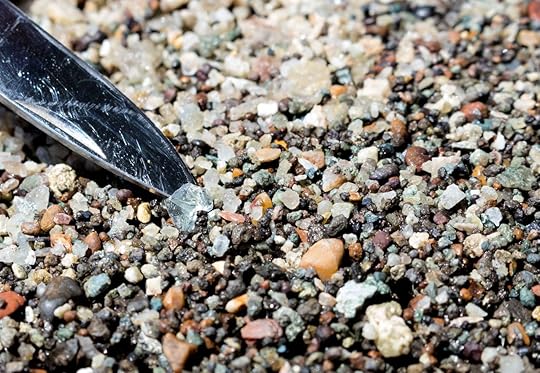
Photo: Kimberly Boyles/Shutterstock
Located in Pike Country, Arkansas, Crater of Diamonds State Park is one of the only diamond-producing sites that allow the public to hunt for diamonds right from the source, a 37.5-acre field that was plowed from an ancient volcanic crater. Adults pay $10 and $6 for children between six and 12, which is a small price to pay when you consider the park’s finders-keepers policy. Visitors can also learn more about diamonds and gem mining through interactive exhibits at the on-site Diamond Discovery Center.
Where: Crater of Diamonds State Park, 209 State Park Rd., Murfreesboro, AR 71958, US
Additional stops: Half an hour northwest of the next stop on our list is a secondary gemstone-hunting site in Georgia that’s worth a visit if time permits: Jackson’s Crossroads Amethyst Mine. Here, rockhounds can dig through large granite rocks in search of amethysts bearing vibrant shades of purple and violet, with blue and red tones that make each specimen unique.
where: Jackson’s Crossroads Amethyst Mine, Hollis Norman Rd., Tignall, GA 30668, US
Graves Mountain, Georgia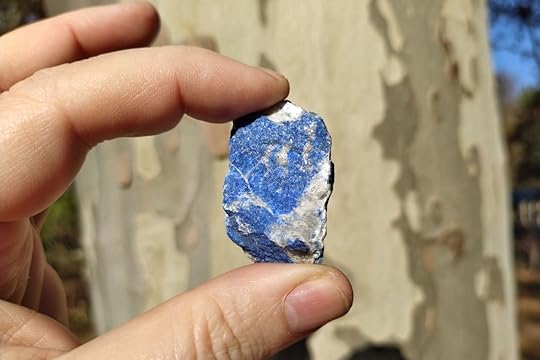
Photo: GOR Photo/Shutterstock
The next stop on our cross-country rockhounding road trip takes us to Georgia, specifically Graves Mountain in Lincolnton off Highway 378. The list of crystals and minerals visitors can find here is long, among them quartz crystals, blue quartz, kyanite, lazulite, muscovite, and a variety of microcrystals. Note that Graves Mountain is an appointment-only site.
Where: Graves Mountain, 2257 Washington Hwy, Lincolnton, GA 30817, US
Additional stops: Roughly an hour north of Graves Mountain and Jackson’s Crossroads, conveniently located en route to North Carolina, is the Diamond Hill Mine in Abbeville, South Carolina. Road-trippers should consider planning a visit here if they’re interested in continuing their search for beautiful quartz crystals.
Where: Diamond Hill Mine, 100 Diamond Mine Rd., Abbeville, SC 29620, US
Emerald Hollow Mine, North CarolinaOf the many stops on this list, the Emerald Hollow Mine in Hiddenite, North Carolina, is among the most famous. According to its website, it’s the only emerald mine in the world that invites the public to try their hand at prospecting. This can be done in several ways: sluicing, which involves sifting through ore at a washbasin; creeking, which involves panning for gems at the on-site creek; and digging at the mine. Emerald Hollow also has an on-site lapidary where rockhounds can have their finds cut and polished by appointment only.
Where: Emerald Hollow Mine, 484 Emerald Hollow Mine Dr., Hiddenite, NC 28636, US
Additional stops: Between the emeralds in Hiddenite and the huntable treasures at the Cherokee Ruby and Sapphire Mine in Macon County, North Carolina is a must-stop for any Big Four gem-hunter. Rubies, in particular, are the draw here, as the site advertises itself as the only public mine in North Carolina that invites visitors to hunt for them.
Where: Cherokee Ruby and Sapphire Mine, 41 Cherokee Mine Rd., Franklin, NC 28734, US
Herkimer Diamond Mines, New York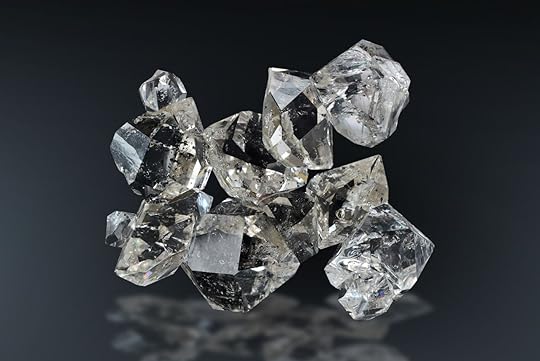
Photo: Albert Russ/Shutterstock
Next up for road-trippers is the Herkimer Diamond Mines in New York, located roughly between Syracuse and Albany. You won’t find actual diamonds here, rather quartz crystals that have a similar shape and date back almost 500 million years. Prospectors should expect to work hard for their finds here, wielding tools like hammers, crowbars, sledgehammers, and chisels to break specimens out of rocks. Sluicing is also available for younger miners. For a slower, more immersive experience, road-trippers can also camp at the on-site KOA resort.
Where: Herkimer Diamond Mines, 4601 NY-28, Herkimer, NY 13350, US
Additional stops: Depending on time and availability, visitors may want to keep the adjacent Crystal Grove Diamond Mine in Herkimer Country on their radars, too.
Where: Crystal Grove Diamond Mine, 161 Co Rd. 114, St Johnsville, NY 13452, US
Mount Mica Mine, Maine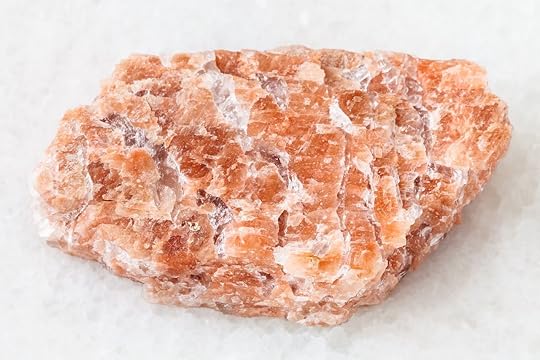
Photo: vvoe/Shutterstock
From the Northwest to the Northeast, Maine’s Mount Mica Mine is the perfect place to wrap up our treasure-filled road trip. According to the Maine State Museum, Mount Mica was the first pegmatite gem mine in North America, which refers to its coarse-grained crystalline igneous rocks. The often watermelon-hued gem tourmaline is particularly significant here, though it’s known for having a fluorescent blue-green color at Mount Mica. Due to weather restraints, rockhounding is only available from May to October in the Paris, Maine, area. 
The post This US road trip will take you to the best places to dig for gems appeared first on Matador Network.
The best traditional souvenirs from Mexico’s most visited regions

Walk down the main street of any tourist destination in Mexico, and you will be overwhelmed by tchotchke shops. Key chains, shot glasses, and t-shirts bearing silly and often crude expressions are everywhere you look, with the tenderos (shopkeepers) eagerly beckoning you to come inside and get yourself souvenirs from Mexico.
Though tempting, we urge you to resist: Mexico is teeming with incredible artisans whose works are much worthier of your dollars than anything you’ll find in a discount bin.
Artisanal Mexican crafts and goods are all inspired by, and intrinsically linked to, the land and its history, largely defined by three geographical regions that predate present state lines: the desert, the mountains, and the rainforest. The nature and subcultures of these regions have influenced the creative spirit of the Mexican people; though styles differ between pre-Hispanic, colonial period, and modern craftsmanship, all tell a story that is authentically Mexican.
If you want to take some of Mexico’s spirit back home with you, we recommend finding a “mercado de artesanías”. It is an easy way to shop your way around the country (we love La Ciudadela in Mexico City, for example), but it’s even better to visit the source and buy from and support a maker directly. Here are some of our favorite traditional wares that make for great Mexican souvenirs, and where to find them.
Matador Network will be taking travelers on adventures to Mexico in 2022. For more details, check out Matador Trips.
Obsidian
Photo: carlos.araujo/Shutterstock
Pre-Hispanic craftsmanship from the mountains
Found in Mexico State and Hidalgo
Obsidian is a type of volcanic glass formed from lava. A major export of the ancient city Teotihuacán more than 2,000 years ago, the black, shiny rock was used to make weapons and tools, as well as decorative items such as figurines, vases, jewelry, and masks. Today, obsidian is still found nearby and linked to “The City of the Gods.” Artist Miguel Mestiza Tovar carves rocks from local mines into masterpieces and, in partnership with local tour guide Rodrigo Salas, happily gives tours of his workshop Casa Meztli, located just steps away from the Teotihuacán pyramids.
Talavera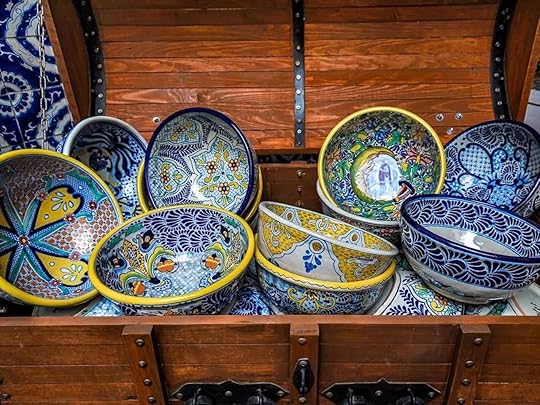
Photo: Uriarte Talavera/Facebook
Colonial period and modern craftsmanship from the mountains
Found in Puebla
Though this glazed, ceramic pottery originated in Spain, it has become synonymous with Mexican culture; Poblano culture (from Puebla, MX), in particular. Puebla is currently the largest producer of Talavera in the world, and the best place to find makers of beautiful dishware, pots, and tiles. While authentic Talavera can be crafted in up to six approved colors (blue, yellow, black, green, orange and mauve), you will most often see classic white and blue designs. The color blue was once the most expensive pigment, which made owning Talavera a status symbol, as well as ensured the quality of the pottery. Uriarte Talavera, an exporter and gallery with locations in Puebla and Mexico City, has designs that span from the 16th to the 21st century, all of which are handcrafted by proud Poblano craftsmen.
Amate
Photo: Pete-I Santos Rojas/Facebook
Pre-Hispanic craftsmanship from the mountains
Found in Puebla and Guerrero
Mexicans have been making amate paper from tree bark since the first century. It was originally used as writing paper, but is now primarily a canvas for incredible artwork. Indigenous Nahua artists paint colorful scenes on amate in Guerrero, whereas the indigenous Otomi of Puebla create intricate cut-out designs; the latter style was banned by the Spanish during the Conquest of Mexico after colonizers alleged it was being used for witchcraft. The small Poblano village of San Pablito worked hard to preserve the tradition despite the ban, and is now seen as a top destination for authentic amate. Buy it from San Pablito’s Santos Rojas family, who sell items from their workshop as well as give tours and classes.
Huichol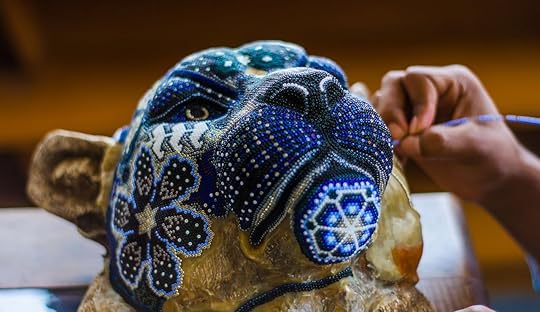
Photo: Tierra Huichol/Facebook
Pre-Hispanic craftsmanship from the desert and mountains
Found in Durango, Jalisco, Nayarit, and Zacatecas
The indigenous Wixáritari people, also known as the Huichol, are arguably Mexico’s most ancient tribe; they are believed to have settled along the Sierra Madre Occidental more than 15,000 years ago and are one of the few ethnic groups to have maintained a firm grasp of their native culture throughout (and despite) colonial and modern times. The Huichol are well-known for their reverence of the hallucinogenic peyote and their gorgeously trippy beaded artwork, which bears the tribe’s name. Brightly colored beads are pressed into beeswax covered wood; figurines, particularly of animals, are one of the most common designs. Tierra Huichol is a gallery and store in popular Puerto Vallarta and Sayulita that displays and sells the original work of eight localWixáritari artists.
Cobre
Photo: Cobre Moderno/Facebook
Colonial period craftsmanship from the mountains
Found in Michoacán
Metal working with cobre, which means “copper” in Spanish, was developed during Mexico’s pre-Hispanic period, but became a more prominent craft during the colonial period, when the Spanish pushed for the mining of the lucrative natural resource. The state of Michoacán had the largest deposits and was thus the main site of extraction. Pueblo mágico (“magical town”) Santa Clara del Cobre remains a headquarters of sorts today, with more than 2,000 coppersmiths working across 300+ workshops. The folks behind Cobre Moderno are third-generation master craftsmen, and use their hammers to create expert kitchenware, jewelry, and vases.
Bejuco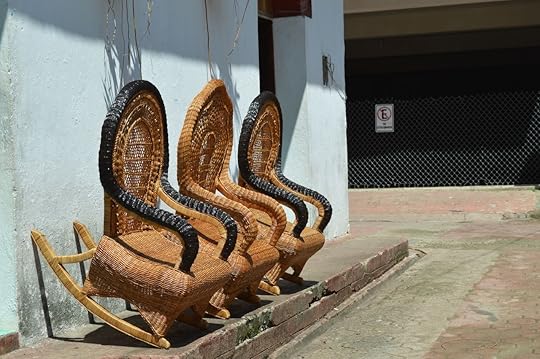
Photo: Merlo/Shutterstock
Pre-Hispanic craftsmanship from the rainforest
Found in Tabasco
Basketry is a widespread, ancient craft; in Mexico, it’s said to pre-date ceramics and even the domestication of fire. One of the most common materials used to weave baskets is bejuco, a vine-like plant native to the region. The bejuco vines are extracted and dried in the sun before being peeled, moistened, and woven into baskets. Bejuco furniture has become quite popular; Tabasco’s town of Emiliano Zapata is known for it. Visit Casa de las Artesanías for a great selection.
Huipil
Photo: All a Shutter/Shutterstock
Pre-Hispanic craftsmanship from the mountains
Found in Chiapas, Guerrero, and Oaxaca
Huipil are the classic embroidered blouses and dresses that you see in every Mexican mercado, but they really are commonly worn by indigenous women, even today. In the Oaxacan region Istmo de Tehuantepec, wearing huipil is a huge part of the local identity, to the point where it is referred to as one’s “skin.” The loose-fitting cotton garment can be worn casually, with more intricately decorated pieces serving as formalwear. Istmo de Tehuantepec based Huipil de mi Corazón makes chic huipil for the modern woman and sells them in pop-up shops in Oaxaca City.
Hipil
Photo: vermontalm/Shutterstock
Colonial period craftsmanship from the rainforest
Found in Yucatán
A variation of the traditional huipil, hipil (note the difference in spelling), also known as terno, is more Spanish-inspired in design, and worn by the mestiza women of the Yucatán Peninsula — those who come from mixed Native and European backgrounds. Rather than being one garment, it is often comprised of three parts: the “hipil,” a closed jacket that reaches the knees, the “doublet,” a square flap attached to the neck of the hipil, and the “fustán,” a petticoat type bottom that fastens at the waist. Buy modern style hipil at Hipil Blusa Yucateca in Mérida.
Barro negro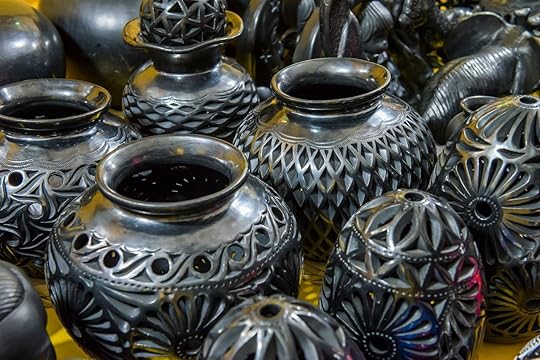
Photo: VG Foto/Shutterstock
Pre-Hispanic and modern craftsmanship from the mountains
Found in Oaxaca
Barro negro, Spanish for “black mud,” is an ancestral Oaxacan style of pottery that is still used today. The pieces traditionally had a gray, matte finish, and were mostly used for practical purposes, but artists discovered in the 1950s that polishing the nearly dry clay before firing it in the kiln would turn it to a shiny black color, like obsidian. This made barro negro explode in popularity. The town of San Bartolo Coyotepec has been making barro negro pottery for about 2,000 years; all the crafts that Lula’ Naya’ Ni, a merchant at the Mercado de Artesanías, sells are handmade by local indigenous artisans.
Sarape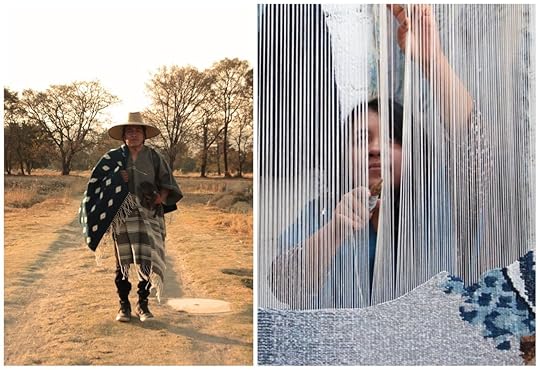
Photo: Arte textil Netzahualcoyotl/Facebook
Colonial period craftsmanship from the desert
Found in Tlaxcala, Coahuila, and Jalisco
Sarape, also known as jorongo, is a brightly colored, striped and fringed cloak worn by Mexican men. While traditionally it was woven in one rectangular piece like a blanket, it’s now common to find an opening in the center to put your head through, similar to a poncho. It rose in prominence in Saltillo, Coahuila during the colonial period, and was primarily worn by wealthy men of Spanish descent. They caught the eye of tourists during the 1920s, and by the 1930s, most sarapes were machine-made, rather than woven by hand. The artisans of Taller de Arte textil Netzahualcoyotl in Tlaxcala, however — led by indigenous Nahua artist Ignacio Netzahualcoyotl — are one group that still carefully and proudly makes the textiles by hand.
Silver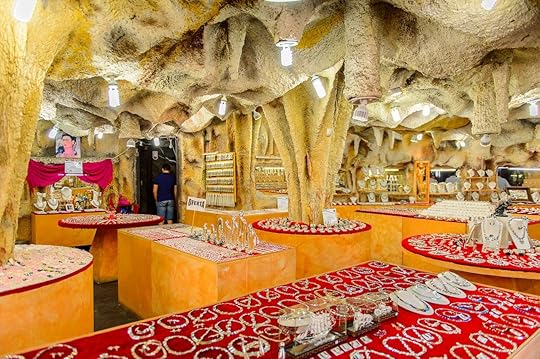
Photo: Anton_Ivanov/Shutterstock
Colonial period craftsmanship from the desert
Found in Zacatecas and Guerrero
Mexico is one of the largest producers of silver in the world. It wasn’t particularly valued during the pre-Hispanic era, but became very popular after the Spainards arrived; many expertly crafted silver pieces from this time period, like dishes and candelabras, are exhibited in museums around the world. Today, more than half of the county’s silver comes out of the state of Zacatecas, making it a great place to buy; the same goes for Taxco de Alarcón in the state of Guerrero known as the silver capital of the world. The town is bursting with silversmiths and platerias (silver shops), so we recommend shopping around for a piece you love. Silver is typically priced by the weight, but do keep in mind that quality can vary: it’s best to only purchase pieces with at least a .925 stamp, meaning it is made up of 92.5 percent Sterling silver and 7.5 percent copper.
Huaraches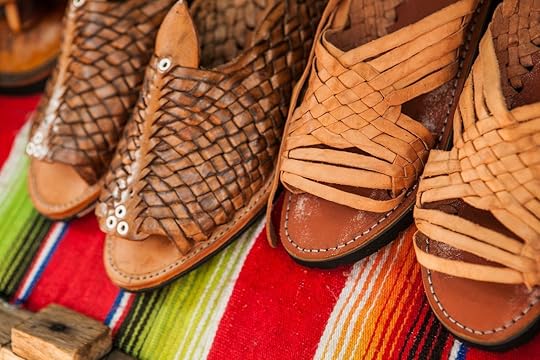
Photo: MILA Zed/Shutterstock
Pre-Hispanic craftsmanship from the mountains
Found in Michoacán and Jalisco
Huaraches are flat, braided leather sandals that were used during pre-Hispanic times to dress the dead; the belief was that the huaraches would help them reach different levels of the underworld. Today, they are popular for casual wear throughout the Americas. Huaraches are made by softening leather in oil and water overnight then weaving the pieces onto the shoe’s sole. Art with Leather in Puerto Vallarta has an excellent selection of authentic huaraches, as well as wallets, handbags, and other leather goods.
Papel picado
Photo: Lorena Huerta/Shutterstock
Pre-Hispanic inspired modern craftsmanship from the mountains
Found in Puebla and Mexico City
No matter where you buy it, papel picado will likely be the easiest to find and most affordable piece of Mexican folk art available. Artisans use sharp scissors to cut intricate designs into sheets of tissue paper, stringing them together into a banner. It is typically used to decorate ofrendas (altars) for Dia de Muertos, the Day of the Dead, but can also brighten up your home or street year round. A modern take on amate, papel picado originated in Puebla’s San Salvador Huixcolotla. Art and party supply stores selling them are everywhere, though Artesanias Reynoso has a particularly good selection. Papel picado are easy to pack up in your luggage, yet culturally meaningful, making for one of the best souvenirs from Mexico. 
The post The best traditional souvenirs from Mexico’s most visited regions appeared first on Matador Network.
How to plan the ultimate trip on the Rocky Mountaineer through Utah and Colorado
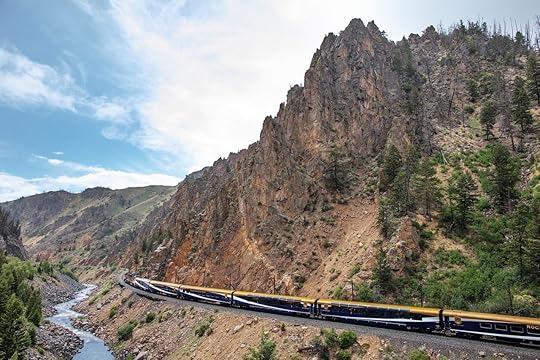
The American West is legendary for its untamed rugged beauty, with the snow-capped peaks of the Rockies rivaling the red pinnacles of the Arches National Park. But driving through the breathtaking gorges is not for the faint of heart. With many narrow roads snaking along the precipitous edges of steep cliffs, the scenic rides often turn into tense, white-knuckle drives where the anxious motorists can’t take their eyes off the unpredictable path that lies ahead, let alone enjoy the views. If only someone else would do the driving.
Now, someone else is offering to do it. Rocky Mountaineer, a Canadian luxury train company known for its domestic scenic journeys, has just launched its inaugural route in the USA, bringing the Rocky Mountaineer to Colorado and Utah. Chugging along between Moab, the gateway town to the several iconic national parks, and Denver, the breathy capital of Colorado, the train offers a relaxing journey through some of the most beautiful mountainous canyons, while serving gourmet food and wines. Rocky Mountaineer’s two-day basic package includes a ride between Moab and Denver, with a night stopover in Glenwood Springs for $1100 per person. A notch up from that, their Rockies to the Red Rocks Classic journey adds overnight stays in Moab and Denver for $1619 — and is well worth it. Although it may seem pricey, the overall experience is akin to a luxury cruise. And because that quick two-day ride is bound to only whet a traveler’s appetite, the company offers a total of 24 tack-on packages, plus you can always add a night or two on your own. With so many choices, here’s one easy itinerary, along with a few potential extras.
Wander in MoabYour Rockies to the Red Rocks Classic adventure begins in Moab, a mountain town hugged by the towering red cliffs with gorgeous views in nearly every direction. Take your time to browse its downtown shops for souvenirs and hiking gear. For a small town, Moab has a surprisingly epicurean food scene— for dinner relish seafood ceviche and perfectly sizzled stakes at Josie Wyatt’s Grille. As you overnight at the spacious Hyatt Place, go stargazing from its rooftop pool and Jacuzzi. There’s an option to tour some of the parks—choose the Salt Lake City Excursion package that includes a half-day trip to Canyonlands National Park and Dead Horse Point State Park for a little over $2000. Want to start as far as Las Vegas or see more natural wonders like Bryce Canyon and Zion National Park? There are options for that, too.
All Aboard the Rocky Mountaineer to Colorado
Photo: Rocky Mountaineer/Facebook
On your departure date, a bus delivers you to your glass-dome coach car. The massive windows allow a 360-degree view throughout the journey. Wide and comfortable, the seats offer plenty of legroom. Open platforms between cars let you take loads of photos while meals and libations are delivered to your seat. By the way, there’s no need to lug your luggage to the train. Leave your bags in your room and they will be seamlessly delivered to your next hotel.
As your train departs, it takes you on a spectacular ride along the chiseled red rocks of the Arches National Park and the La Sal Mountains. As you marvel at the otherworldly formations, let your imagination run wild — some of them may look like bastions of an ancient fort, some like the skyscrapers of Wall Street, and others like Egyptian sphinxes. Your onboard hosts will tell stories about the places you’re passing. As the train crosses the state line from Utah to Colorado, you’ll travel through the beautiful Ruby Canyon. After a while, you pass by the town of Grand Junction, once the state’s first vineyard planted in 1890. It will be followed by Palisade, Colorado’s wine country and an agricultural region with bucolic views of green fields and famous peach orchards.
When dinner time comes, ale-braised short ribs and foraged mushrooms are not to miss. What’s more, your meals come with an ever-changing view. You may savor your entree as you glide by the ancient stone formations and dig into dessert while watching rafters braving the rapids on the Colorado River.
Soak in Glenwood Springs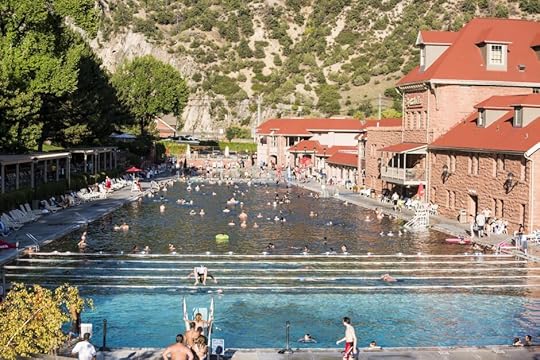
Photo: Andriy Blokhin/Shutterstock
Shortly after dinner, you arrive at Glenwood Spring, a Wild West mountain town steeped in history. Touted as a wellness destination for its mineral hot springs, it was favored by many famous visitors including gangster Al Capone, legendary Wild West performer Buffalo Bill and dentist-turned-gunfighter Doc Holiday. The legendary figures are long gone, but the hot springs are still there, so once you check into Glenwood Hot Springs Resort where your bag is already waiting, unpack your swimsuit and dive in. The town’s central bathing house boasts massive hot and warm pools, along with a diving board, and the relaxing soak will assure a good night’s rest. Be sure to set your alarm so you don’t oversleep in the morning.
Down to DenverYour journey will resume early next morning as you indulge in waffles and berries while passing through the forest-covered Glenwood Canyon. Shortly after on your left, you might spot Roundup River Ranch, which belongs to actor Paul Newman. The breathtaking vistas of Gore Canyon and Byers Canyon will follow as the train chugs along the weaving Colorado River.
Stay tuned to your onboard hosts’ announcements, and keep your eyes peeled to the lush forests for wildlife viewing. Although not guaranteed, deer, elk, moose, and even bears have been spotted along the train tracks. And you may see some humans, too—these parts of the Colorado River are popular with rafters and kayakers. Savor coriander-crusted salmon for lunch, wash it down with a glass of Prosecco and be sure to take plenty of pictures.
Re-Discover Denver
Photo: Arina P Habich/Shutterstock
Arrive to Denver just in time for dinner at Mercantile Dining and Provision, a European-inspired eatery at the city’s downtown Union Station train depot. It’s easy to stay at the Crawford Hotel, located within the station’s wings. But if you’re willing to go the extra mile or two in this Mile High City, consider Denver’s newest addition — the Catbird hotel in River North or RiNo district, a trendy neighborhood lined with brewpubs and food halls. Opened on Friday the 13th of August, Catbird is a happy marriage of an art gallery and a sophisticated modern home where rooms are decked with a loft bed, breakfast to order, and a myriad of stylish shared spaces filled with cozy chairs. A home-away-from-home, Catbird beckons for a couple of extra Denver days, which you can pack with plenty to do.
One of the fastest-growing metropolises in the country, Denver boasts dozens of art galleries and hundreds of murals that street artists paint on the city’s walls using them as living canvases. For a fun city excursion, choose the eTuk tour, an electric version of a tuk-tuk that quickly brings you up to speed on all Denver attractions—bustling markets, booming pubs, and historic buildings. Be sure to visit the Denver Art Museum, which offers a priceless collection of French impressionists and a gift shop full of affordable artistic creations you can take home with you.
Known for its artisanal brewery scene, Denver also boasts many high-end restaurants. Swing by its latest posh Mexican spot Bellota, only minutes from Catbird. For your farewell night, opt for outdoor dining at Rioja, which serves Mediterranean food with a twist (think artichoke-goat cheese tortelloni and lamb loin) in the city’s historic Larimer Square where street musicians play. If time permits, stay for a concert at the Red Rocks Amphitheater, the unique open-air performance venue built within the giant natural sandstone outcroppings. It would be an unforgettable grand finale to your epic rail journey from the Rockies to the Red Rocks. 
The post How to plan the ultimate trip on the Rocky Mountaineer through Utah and Colorado appeared first on Matador Network.
Mesmerizing aerial images from the Drone Awards 2021

The pandemic has resulted in some outstanding photography. Many talented creatives around the world have had more time to focus on passion projects and for those who draw on the earth and wildlife for inspiration, we’ve seen some outstanding artwork — especially from drone photographers. This week the results of the international Drone Photo Awards 2021 were announced and the collections are out of this world.
The awards are sectioned into the following categories: urban, wildlife, sport, people, nature, abstract, wedding, and series. Photos were submitted from over 102 countries and the final cut will be showcased in an exhibition dedicated to the visual arts from October 23 to December 5 as part of the Siena Awards Festival in Siena, Italy.
Here are some of our favorites from the Drone Photo Awards 2021. To view other entries and the winners of each category visit the official website.
“Pink-Footed Geese Meeting the Winter” by Terje Kolaas
Photo of the Year, Wildlife

Photo: Terje Kolaas/Drone Photo Awards 2021
Thousands of pink-footed geese fly to the breeding grounds on Svalbard in the Artics.
“Hippopotamus Group From Above” by Talib Almarri
Highly Commended, Wildlife

Photo: Talib Almarri/Drone Photo Awards 2021
A group of adult hippopotamus a calf gather together creating a unique pattern.
“The Tower” by Kristian StigelCommended, Urban

Photo: Kristian Stigel/Drone Photo Awards 2021
This newly built tower reaches 147 feet high and this photo was shot early morning before tourists engulf the attraction.
“Chishan Lake in Winter” by Wujiang Zhu
Commended, Abstract
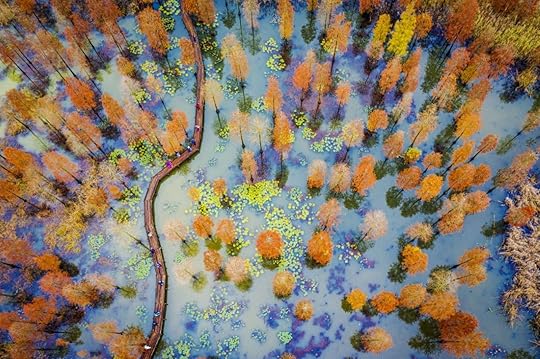
Photo: Wujiang Zhu/Drone Photo Awards 2021
Chishan Lake Park is named after the largest “Chishan forest” in East China.
“Labyrinth of Time” by Tomáš Neuwirth
Commended, Nature

Photo: Tomáš Neuwirth/Drone Photo Awards 2021
The digital collage was created by photographing a labyrinth in the park of Priessnitz Spa during two seasons.
“Sailor of Red Chilies Sea” by Sujon Adhikary
Commended, People

Photo: Sujon Adhikary/Drone Photo Awards 2021
A farmer riding through a sea of red chillis.
“Bank of Buriganga” by Md Tanveer Hassan Rohan
Commended, Urban
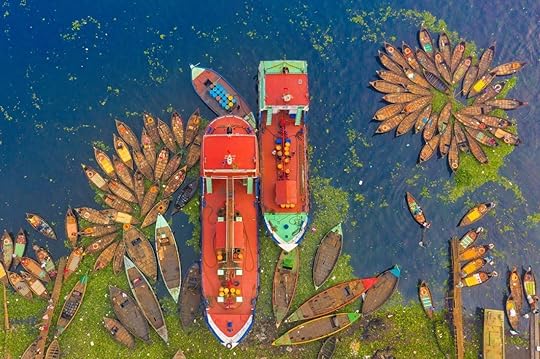
Photo: Md Tanveer Hassan Rohan/Drone Photo Awards 2021
Boats from the bank of the river Buriganga during the pandemic in Bangladesh.
“Baby Flamingos” by Seyit Konyalı
Commeneded, Wildlife
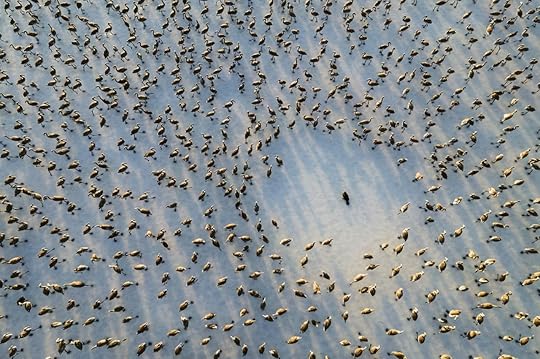
Photo: Seyit Konyalı/Drone Photo Awards 2021
A flock of baby flamingos on a salt lake.
“Beach Season” by Alexandr Vlassyuk
Runner Up, People
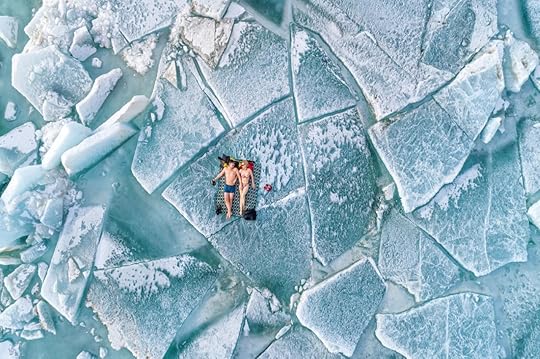
Photo: Alexandr Vlassyuk/Drone Photo Awards 2021
Two beachgoers lie on ice hammocks at the Kapchagai reservoir in the Almaty region.
“Floating People” by Raf Willems
Commended, People
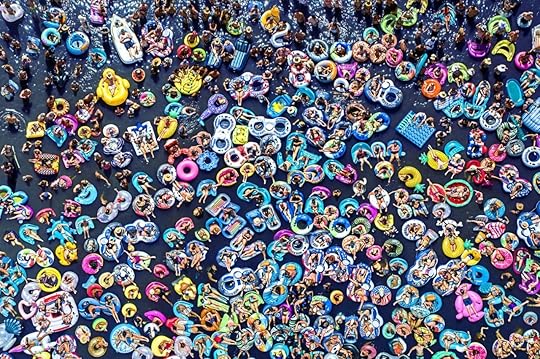
Photo: Raf Willems/Drone Photo Awards 2021
This image captured a crowd packed into a lake in inner tubes while attending a concert.
“Poodle in Rapeseed” by Jan Ulicki
Commended, Nature

Photo: Jan Ulicki/Drone Photo Awards 2021
A small poodle-shaped forest surrounded by rapeseed fields.
“Volcano Show” by Oleg Rest
Commended, Nature
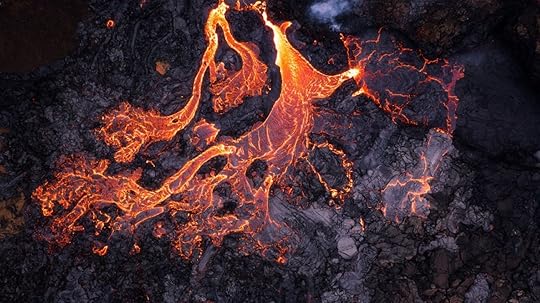
Photo: Oleg Rest/Drone Photo Awards 2021
The Fagradalsfjall volcano in Iceland erupted in April 2021. 
The post Mesmerizing aerial images from the Drone Awards 2021 appeared first on Matador Network.
Why do Olympians love Sun Valley?

In the 1930s, the Austrian Count Felix Schaffgotsch was scouring the US for a potential site for the world’s finest ski destination. Upon seeing central Idaho, he wrote, “Among the many attractive spots I have visited, this combines the more delightful features of any place I have seen in the United States, Switzerland, or Austria for a winter ski resort.”
Based on Schaffgotsch’s endorsement, Averell Harriman — chairman of Union Pacific — built just that resort. He hired the best skiers and ski instructors in the world to come live and work at his new ski destination, Sun Valley. Ever since then, this small resort town has been attracting world-class athletes, world-class adventurers, and world-class outdoor entrepreneurs.
But what was it exactly that originally attracted Schaffgotsch? What can explain Sun Valley’s magnetic pull? And how has it persisted for nearly 100 years?
The local athletes: Inspiring and incognito
Photo: Ray Gadd
Nowadays, three generations of Olympic medalists and adventure superstars call this small Idaho town in the Northern Rockies — population 1,473 — home base and daily training zone. But you’d never know it: Try picking them out of the crowd during a powder day on Baldy’s 3,400-foot vertical drop, on their bikes riding up Trail Creek, hiking the local trails, fishing the creeks, running errands around town, or playing with their kids at the park.
The truth is, they look a lot like every other Sun Valley local or visitor, blending in quite seamlessly with a community chock full of unassumingly bad-ass adventurers. After all, Sun Valley is home to the inspiringly fit and the aspiringly adventurous, where 70-year-old trail runners cheerfully greet you as they waltz past going uphill, where pros wear their status like a good base layer — comfortably, but undercover. It’s hard to tell the difference between your dog’s vet, the chef at your favorite restaurant, a local elementary school teacher, and all those famous Olympic medalists, pro skiers, mountain climbers, expedition leaders, and every other type of adventure superstar. They’re called here because they fit right in.
A who’s who of Sun Valley adventure stars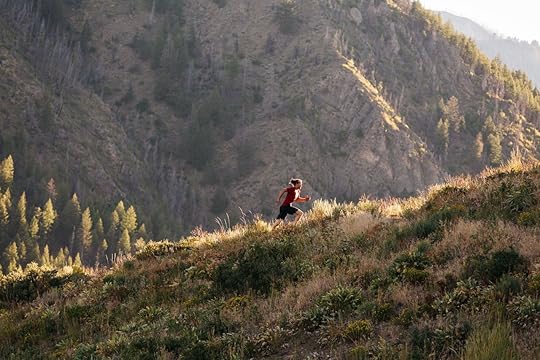
Photo: Caroline Woodham / Visit Sun Valley
The list of professional athletes and adventure heroes with roots here is a long one: 56 former and current Olympians hail from Sun Valley, including 2014 Olympic Gold Medalist Kaitlyn Farrington and 1948 Gold Medal winner Gretchen Fraser. The roster also includes endurance athlete Rebecca Rusch; X-Games gold medalists and big-mountain skiers Zach and Reggie Crist; professional mountain climbers Ed Viesturs and Peter Whittaker; pro skier Karl Fostvedt; and expedition kayaker, Mt. Everest cameraman, and all-around adventure guru Gerry Moffatt. These names barely scratch the surface — and they certainly don’t include all the incredible athletes and adventurers who have come before us.
Nor should we neglect the number of outdoor entrepreneurs who helped create the special cultural fabric so singular to Sun Valley, like the founders of POWDER Magazine. Following in the footsteps of early Sun Valley ski-film pioneers such as Warren Miller and Dick Barrymore, brothers Jake and Dave Moe launched POWDER Magazine in 1972 from a small office in town. Celebrating the people who made skiing cool and the coolest thing of all — skiing powder — POWDER has inspired countless skiers with their motto, “If you’re not having fun, you’re fired!”
Why Sun Valley?
Photo: Ray J.Gadd Photography / Visit Sun Valley
The reasons why so many of these remarkable and talented individuals are drawn to Sun Valley differ for each person, but it’s safe to say it all boils down to a few key factors. Sun Valley has that rare combination of adventure opportunities out your front door paired with a vibrant, fun-loving, quietly-kickass-yet-wildly-cultured local community. This potent mixture creates a unique mountain town and lifestyle, one that celebrates spending lots of time outside in the fresh mountain air with good friends, getting plenty of exercise at and above 6,000 feet, and enjoying an abundance of cultural resources — like a world-class four-season resort, nationally recognized theaters and performance arts groups, critically acclaimed film festivals, a plethora of amazing restaurants, and residents that value freedom, adventure, and the natural environment.
At its very roots, the culture and community here couldn’t care less about how much money you have, how famous you are, or what your last name is, valuing instead the experiences, humility, relationships, and simple beauty of a life lived well in the mountains. It’s also a place with an enduring pioneering spirit — from the world’s first chairlift to the first aluminum ski pole, double-lens goggle, collapsible ski, and countless other advancements in outdoor equipment design, Sun Valley has always been a hotspot for innovation. A commitment to staying chain-free and locally owned and operated keeps Sun Valley authentic to itself, while also providing a future that’s both sustainable and diverse.
When you combine all these factors, it’s easy to see why the very people whose careers and livelihoods extend from free-spirited adventure and athleticism choose to call Sun Valley home. If you ask any of them, though, they’ll probably say the same thing: It’s the local people that make this place so special. There’s an easy-going and accepting vibe that pervades everything, freeing Sun Valley from the tiresome hype and competition found in other mountain towns.
At the end of another long sunny day spent playing in the mountains, lying beneath a star-filled sky, listening to the river roll on by, or watching snow fall and stack up on the evergreens outside — surrounded by friends and family — it’s easy to understand why the idea of personal success is a little different in a place like Sun Valley. 
The post The adventure hero next door: Why so many Olympic medalists and adventure superstars call Sun Valley home appeared first on Matador Network.
10 fun TikTok trends for couples to try out when traveling

TikTok has opened up a whole new realm of creative possibilities, especially for destination reels and fun challenges to jump on with your partner in crime as you travel around the world. However, for new users, it sometimes becomes daunting to find these challenges, and to figure out how to execute TikTok travel trends. We’ve compiled 10 of the most popular and fun TikTok travel trends from couples all over the world for you to try out on your next trip.
Finger snap!@nanocalderon97🇲🇽Resumen de nuestro viaje❤️ #parati #viaje #mexico #viral #fyp #travel #couple
You’ve probably seen it, it’s all over TikTok and it’s one of those trends that just doesn’t die out. Why? Because it’s one of the easiest ones to execute without having to spend too much time on your phone when you’d rather be taking in the beauty of your surroundings… or enjoying each other’s company.
How to do it:Remember to record a one-second clip of your hands finger-snapping in front of all the different places that make up your trip together.Once you have all the clips you want to use, scroll through TikTok to find one of these videos. Make sure you use the search tool and use a travel-related hashtag, such as #traveltok or #travelcouple.When you’ve found one, click on the audio, and make sure you save it to Favorites.Now that you have the clips and the sound, all you need to do is head over to the ‘+’ sign, add the sound from your Favorites. Then add every finger-snapping clip from your library, and TikTok will do the rest with auto-sync.Bungalow run-through@anna.fackrate the view at the end!! would you stay here?!😍breathtaking! #borabora#funnycouplesgoals#couplesvideo#travelcouplegoals#travelcouplelife
♬ My House (Challenge Version) – Flo Rida
Heading to an amazing rental home with a pool overseeing some breathtaking views? You might love this one.
How to do it is easy enough. Hit record and grab hold of your partner’s hand and have them guide you across the bungalow and into the pool. Don’t forget to get a waterproof phone case to avoid a tech disaster.
How to do it:Save the sound from a similar video to Favorites.Have your partner take your hand as they record you running in front of them through the bungalow.Jump with them in the pool, or let go of their hand as they record and jump in the pool.Add clip and sound, auto-sync and publish!Passport reel@thattravelcoupleTravel together Stay together Tag your travel buddy #thattravelcouple #travelgoals #foryoupage #foryou #fyp #tiktoktravel #travelcouple
♬ Jaymes Young – Happiest Year – 99
This is another one of those #traveltok trends that never seem to go out of fashion. All you have to do here is take a first selfie with your partner at the airport holding your passports and cover the camera with them slowly for the transition. All that’s left is making sure you’ve got some clips throughout the trip of each other wandering, eating, kissing, exploring. Smash it all together with the right audio and boom! You go viral.
How to do it:Save sound from a similar video onto Favorites.Make a selfie video at the airport of the two of you holding your passports.Slowly move the passports in front of the camera until it goes black.Hit on the ‘+’ sign and add the soundAdd the airport clip, and all the clips you want to add from your trip.Auto-sync and publish!One day, you’re gonna wake up…@theglobewanderersDo what you have always wanted ❤️ #travel #travelbucketlist #life #motivation #wanderlust #travellife #travelcouple
♬ original sound – Jesse J. Pedigo
One of the great things about TikTok is that the sounds that can be used on your clips go way beyond a music library. There are thousands of inspirational quotes with a backdrop of calm music that are perfect for these videos.
Finding those quote-based sounds can be tricky. The most efficient way is to scroll through TikTok with the #TravelTok hashtag and save those sounds onto your Favorites. Some creators, such as Jesse J. Pedigo (@creatingwonders), specialize in making the quote sounds for other users.
There is a lot more creative freedom in quote trends because you can literally choose any and as many clips from your travels. Many creators choose to add subtitles for the quotes on the final video, but if you do this, remember you need to time the duration of each piece of text accordingly. It can be a little daunting, but in the end, it’s totally worth it.
How to do it:Save sound to Favorites.Upload the best clips from your travels together and add the sound.Optional text: Add the captions to the quotes and sync the durations for the whole video.Publish!Fist bump!@georginariba98Made it #trip #couple #travel #foryou #parati #clap #2021 #fyp #plane #beach #sunset
The concept for this one is the same as the finger-snapping one we first mentioned. Fist-bump your partner with different backdrops of your trips, smash it all together, add sound, and watch TikTok make magic happen.
How to do it:Find a similar video and save the sound to Favorites.During your trip, remember to record one second of your hands fist-bumping in front of all the different places that make up your trip together.Head over to the ‘+’ sign, add the sound, and every fist-bump clip from your library and TikTok will do the rest with auto-sync.“When are you having kids?”@jessiwandersDon’t stop until you find your travel partner for life #travel #partner #goals #couplegoals #travelcouple #fyp #foryou #foryoupage #inspiration
This is one of my personal favorites, and one I’m sure many recently married couples out there will love, especially couples bombarded with that constant nagging question from everyone around them: ‘So when will you have kids?’
It’s perfectly fine to want kids, of course, but it’s also perfectly fine to not want them. And travel instead. So next time they ask, maybe having a TikTok answer just that, might do the trick.
How to do it:First of all, make sure you have the audio for this trend saved to Favorites.Then, find a clip of your wedding day, and add the text “Everyone: So when are you having kids?”Add a series of clips of the two of you traveling around the world, and make sure to add the text: “Us:” for the duration of those snippets.Clear water…Cheers!@sydneyandavisClear water #jamaica #bestvacations #travelingourplanet #living_destinations #travelcouple #honeymoon #beach #travel #tiktoktravel
♬ Supalonely (feat. Gus Dapperton) – BENEE
There is nothing quite like the crystal-clear waters of the Caribbean. If you’re heading there together, raising a couple of champagne glasses is one of the easiest and classiest reels to up your game on TikTok.
How to do it:Before recording, get your hands on a couple of champagne glasses.Hit record as you both fill the empty glasses with that crystal-clear water, toast, and let the water fall back into the ocean.Before uploading the clips, make sure you find a similar video first, and save the audio associated with it to your Favorites.Add the clips and audio, and voilá.Life is short, the world is wide…@riotravelersFollow us if you love travel ✈️☺️ #travel #travelcouple
This is another quote-sound that has recently been trending again. As we’ve already mentioned, you can pair these sounds with whatever clips you want, without having to pre-record anything specific for them.
Tip: Make sure you get some clips of your partner exploring as they hold your hand, selfies, bird’s eye views, the two of you toasting at a charming restaurant. Anything goes. The important part is to capture all those moments you don’t want to ever forget.
How to do it:Save sound to Favorites.Upload the best clips from your travels together and add the sound.This is optional but you can also add the captions to the quotes and sync the durations for the whole video.Publish!Traveling as a couple…wait for it@thelucasfamilyTrue or false? #couple #couples #couplegoals #couplecomedy #couplelove #travel #travellife #GetGrafting #holiday #vacationmode #viral #fyp #fypシ #fy
♬ Into The Thick Of It! – The Backyardigans
This is one of the more realistic TikTok trends, and it’s one that allows you to add in a personal touch. Traveling is not always daisies and sunshine, especially as a couple. What is it that best defines your travels together? Do they get annoyed because you’re asking for selfies every second step of the way? Are you the one who always gets lost unless you have your nose stuck to a map the whole time?
Find that thing that defines you as a couple, and own it!
How to do it:Save the sound from a similar video to your Favorites.Decide what defines your travels as a couple and re-enact it in a humorous way.Add the text: “Traveling as a couple… wait for it” in the first few seconds of your clip.Auto-sync and publish!All these years, all these countries@kendallfuhrmanbeing with you feels like this song I love you @alexcarvs #love #soulemate #abba #theboy #gooutside #couplestiktok #travelcouple #luca #bucketlist
♬ Chiquitita x Twilight – twibytez
One of the most defining TikToks you could take as a couple is a reel of all your travels together. This might be something you need to dig out some old clips for, but it will definitely be worth it.
How to do it:Save the sound from a similar video into your Favorites.Dig up all the clips of the two of you together from all the traveling you’ve done over the years.On the first clip, you use, make sure to add the text: “-X- years and -XX- countries later.”Add all the clips of the two of you together traveling the world, hit auto-sync, and watch your whole story come together. More like thisRomanceThe most romantic getaways from major US cities
More like thisRomanceThe most romantic getaways from major US citiesThe post 10 fun TikTok trends for couples to try out when traveling appeared first on Matador Network.
September 10, 2021
This is why your baggage claim is always in the farthest part of the airport

Your flight has landed at your destination and the seatbelt sign is finally off. At this point, you might be antsy to grab your checked luggage (because we all know someone who absolutely must check their luggage) and make your way out of the airport. But how annoying is it after waiting all that time to deplane only to arrive at baggage claim and your luggage isn’t even there?
The person behind the TikTok accoount @designsecretsss claims that airports have learned to ease this frustration with a few simple design changes. He explains that airlines at the Houston, Texas, airport were receiving complaints about the time it took to get their bags. Even after getting the wait down to eight minutes by hiring more staff to assist, the complaints continued. The executives used a clever trick to make baggage wait-times shorter: Move the baggage claim to the far side of the airport so by the time you’ve arrived your bags are already there. He claims that complaints dropped to zero.
The trick is that unoccupied time feels much longer — waiting around with nothing to do in an era that values immediate gratification is not as effective as providing occupied time. Walking from the gate to the baggage claim feels much shorter and is a necessary evil to get to your destination.
@designsecretsssHow an #airport reduced complaints #travel #trip #plane #psychology #design #designsecrets #learnontiktok #fypシ
Matador reached out to United, American, and other airlines (as well as the Houston airport), but as of publish time hasn’t received comment on the validity of the claim. 
The post This is why your baggage claim is always in the farthest part of the airport appeared first on Matador Network.
8 luxury hotels for Quebec and New England fall vacations

The term “leaf peeping” is a bit misleading. It suggests sneaking a quick look at something, or craning your neck out the car window in passing before moving on with your day. More accurate is the term “leaf immersion.” You don’t want to just get a glimpse of the fall foliage, you want to stroll through it, reside among it, be embraced by it. That’s tough to do from inside a moving car. Luckily, there are hotels that unite guests with the great outdoors — a union especially powerful in the fall. From a historic inn tucked into Vermont’s Green Mountains to a stately hotel in Quebec with panoramic mountain views, these are the best hotels for amazing Quebec and New England fall vacations this season.
Blantyre — Lenox, Massachusetts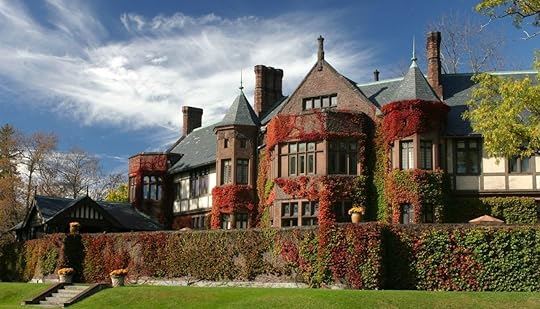
Photo: Blantyre
Where better to take a New England fall vacation than in the heart of the Berkshires? The fall experience at Blantyre in Lenox begins when you first roll down the driveway. Fallen trees have been carved to look like birds of prey and other wildlife, immediately immersing you in nature. The main hall of this mock-Tudor mansion features Gothic revival arched wooden doors, oak panelling, and leaded windows, all overlooking a terrace that’s perfect for some serious fall foliage viewing. The 100-acre hotel grounds are full of private trails for all skill levels, with maps available to plan your day accordingly.
Where: 16 Blantyre Road, Lenox, MA 01240, US
Stowe Mountain Resort — Stowe, Vermont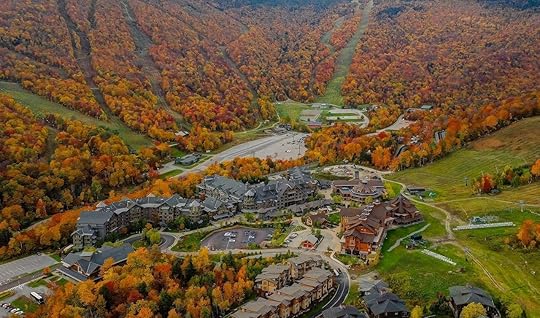
Photo: Stowe Mountain Resort/Facebook
The Stowe Mountain Resort is the perfect base for vacationers looking for a little adventure to go with their leaf immersion. At the base of Mount Mansfield in northern Vermont, the resort is surrounded by woods and equipped with picture windows that give you the best possible views. Apart from the views themselves, you can also take advantage of the season by hiking, going canoeing, fishing, or bouldering, or even taking a zipline ride through the trees. If you prefer something a bit more leisurely than zip lining, the resort also has a golf course onsite with mountainous backdrops that beats any average country club.
Where: 5781 Mountain Road, Stowe, VT 05672, US
Mayflower Inn and Spa — Washington, Connecticut
Photo: Mayflower Inn and Spa/Facebook
This quiet corner of western Connecticut has got all the colors of the fall foliage season. Located in the bucolic Lichfield Hills, the Mayflower Inn and Spa manages to be stately and cozy at the same time. Its floor-to-ceiling windows overlook a garden, and the Steep Rock Reservation is just a five-minute drive away, with trails offering panoramic views of the hills.
Where: 118 Woodbury Road, CT-47, Washington, CT 06793, US
Omni Mount Washington Resort — Bretton Woods, New Hampshire
Photo: Omni Mount Washington/Facebook
At first glance, this hotel in Bretton Woods, New Hampshire, looks more like a palace than a hotel. A longtime favorite retreat for presidents and literary figures, the Omni Mount Washington Resort is one of the country’s best examples of Spanish Renaissance architecture, and was even named a National Historic Landmark. Completely surrounded by trees, there are picturesque views from pretty much everywhere in the hotel. The property is also known for its nine zip lines strung between the hemlock trees — you know, for when you’re not just chilling at the spa. The hotel even offers a three-hour canopy tour that brings you across several zip lines and sky bridges.
Where: 310 Mount Washington Hotel Road, Bretton Woods, NH 03575, US
Four Columns Inn — Newfane, Vermont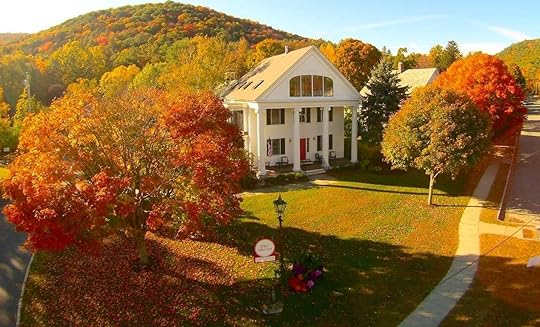
Photo: Four Columns Inn/Facebook
This hotel straddles the line between luxury and quaint, historic charm. Located in the small village of Newfane in Vermont’s Green Mountains, the Four Columns Inn looks like a condensed version of Jefferson’s famous Monticello. Abutting a river and woodlands, and home to several gardens, the inn has no shortage of ways to experience the outdoors. There’s also a restaurant with farm-to-table food, and a spa with an earthy aesthetic that incorporates elements of the natural world.
Where: 21 West Street, Newfane, VT 05345, US
Hidden Pond — Kennebunkport, Maine
Photo: Hidden Pond/Facebook
Located near Goose Rocks Beach in Kennebunkport, Hidden Pond combines the best of both of Maine’s two worlds — coastal living and wilderness. Just two miles away from the beach, the lodging is secluded amid balsam and birch trees, and has a collection of one- and two-bedroom cottages linked by a dirt road. There’s also a main lodge with a stone fireplace, with direct access to a pool area and porch bar. The Tree Spa, where guests can receive spa treatments in tree houses, is probably the hotel’s most standout feature.
Where: 354 Goose Rocks Road, KEnnebunkport, ME 04046, US
Le Bonne Entente — Quebec, Canada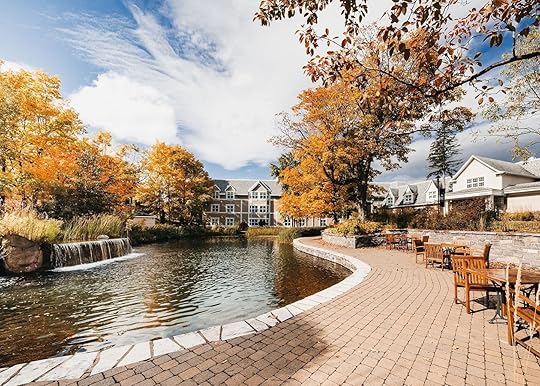
Photo: Le Bonne Entente/Facebook
Although located in Quebec City, Le Bonne Entente makes you feel like you’re at a countryside retreat. Quebec’s fall colors are among the most vibrant in North America, and La Bonne Entente, sitting on a pond overlooking a small woods, allows you to immerse yourself in nature while also enjoying a more pampered experience. It’s also known for its delicious autumn restaurant menu that includes dishes made with locally-sourced ingredients.
Where: 3400 Chemin Sainte-Foy suite Amerispa, Quebec City, QC G1X 1S6, Canada
Fairmont Tremblant — Quebec, Canada
Photo: Fairmont Tremblant/Facebook
There’s really no better place in Quebec to view fall foliage than from the mountain village of Mont-Tremblant. About two hours north of Montreal, this hotel is perched high above the village. The Fairmont Tremblant has some of the best views of the region you’ll find anywhere in Quebec, as well as convenient access to several hiking and biking trails. The hotel also offers complimentary guided walks on Sunday mornings.
Where: 3045 Chem. de la Chapelle, Mont-Tremblant, QC J8E 1E1, Canada 
The post 8 luxury hotels for Quebec and New England fall vacations appeared first on Matador Network.
10 of the most well-loved dishes from across South America
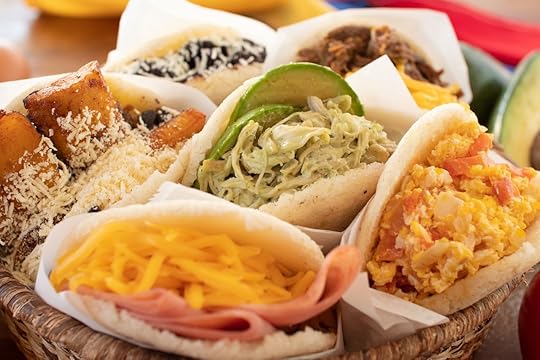
There’s nothing quite like sitting down to a home cooked meal with our loved ones. In South America, many of the most loved dishes have been perfected by moms and grandmothers over a lifetime and then passed down to the next generation.
“Throughout history … there is no doubt that women have been the guardians of culinary knowledge,” writes Chilean author and anthropologist Sonia Montecino Aguirre in her book La Olla Deleitosa: Cocinas Mestizas de Chile. While Montecino Aguirre focuses on Chile, her words reflect broader South American history too: “When we speak of fusion in Chilean kitchens, we cannot forget the role played by women in the continuity or adaptation of dishes, in their adoption or rejection of different culinary practices, in the creation and recreation of various techniques,” she adds. Despite modern pressures, women continue to be central to South American cooking — women were responsible for preparing meals in 93 percent of Latin American households surveyed by Kantar in 2018.
To learn more about home cooking, we asked 10 South American people about their favorite meal. The dishes featured here tell a personal story. They also offer a glimpse into each country’s history, and highlight how communities have come into contact (voluntarily or not) with the multitude of cultures that have shaped South American cuisine.
1. Pesque de quinua from Peru“In Peru, there are so many delicious dishes, though my favorite is anything with quinoa,” Maria Elena Mamani Villavicencio, who was born and raised in Cusco, Peru, says.
Quinoa is a tiny, pale-gold seed that’s been grown for thousands of years across the high plains of South America. Rich in protein and vitamins, quinoa was a staple for pre-Columbian cultures like the Inca, Quechua, and Aymara, and it continues to be a vital part of Peruvian cuisine.
Mamani Villavicencio makes her favorite quinoa dish, pesque de quinua (quinoa stew), by frying onion, garlic, and chili and then simmering potatoes, quinoa, and water until the ingredients are fully cooked. She then garnishes the dish with cheese and huacatay, a native herb similar to tarragon.
“When I was younger, my mother cooked it, and now I do,” Mamani Villavicencio says. “I have an 11-year-old daughter who loves it as well.”
In Cusco, people often eat pesque de quinua during Semana Santa (Easter Holy Week). Traditionally, families prepare twelve vegetarian dishes to eat on either Thursday or Good Friday, in honor of Jesus. “One of them was always quinoa,” says Mamani Villavicencio.
2. Tutu de Feijão from Brazil
Photo: flanovaisShutterstock
“My mother makes the best tutu de feijão in the world,” says Douglas de Oliveira, who lives in the state of Minas Gerais in southeastern Brazil. Tutu de feijão is made by blending beans into a paste and then thickening the mixture with cassava flour. The paste is then cooked over a low heat with onions, garlic, and herbs until it’s creamy. De Oliveira describes this as “a flavor explosion.”
West African people enslaved by the Portuguese and taken to Minas Gerais in the sixteenth and seventeenth centuries first created tutu de feijão. It’s thought that the word tutu comes from Kimbundu, a Bantu language of West Africa. “The dish has African roots, but it was adapted to the Brazilian ingredients enslaved people had access to,” de Oliveira says. One such ingredient is cassava, which has been part of indigenous Brazilian cooking for thousands of years.
While you can find tutu de feijão cooked any day of the week, in Minas Gerais it’s traditionally prepared for the juninas festivals. Each June, in honor of the Catholic saints Anthony, John, and Peter, Brazilians dress up in colorful folk costumes, listen to traditional forró music, dance the quadrilha, and have giant bonfires. “[Tutu de feijão] is a classic part of town celebrations,” de Oliveira says. “I have great memories of chatting with friends and family around a plate of tutu de feijão.”
3. Arepas from Colombia“Arepas, without a doubt, are my favorite food,” says Jose Velasco Merlo of Bogota, Colombia. Arepas are small, round corncakes that can be grilled, baked, or deep fried. “When I was little, my mom would usually cook them every day for breakfast,” he says.
Arepas have a long history in Colombia as well as in neighboring Venezuela, and there’s a friendly rivalry about which country arepas come from. While we don’t know exactly when pre-Hispanic cultures began making arepas, studies show that corn was first cultivated in Colombia over 6000 years ago.
Traditionally, Indigenous women made arepas by soaking corn kernels overnight to remove the husks before cooking, draining, and grinding the corn with a wooden mortar and pestle called a pilón to form a dough. After shaping the dough into discs, the women grilled the arepas on clay plates called aripa or budare, which may be how arepas got their name. In the 1950s, the invention of precooked cornmeal made the process of making arepas quicker, easier and more accessible.
Colombian food anthropologist Julian Estrada Ochoa estimates there are more than 42 varieties of arepa today. These include the famous coastal arepa de huevo, filled with egg and deep-fried, arepa con chicharrón with pork crackling kneaded into the dough, and small plump arepa de bola perfect for eating with stews and soups. Velasco Merlo stuffs his favorite arepas with cheese, chicken, ham, and a boiled egg.
4. Arroz de coco frito from Colombia
Photo: nath_cristovao89Shutterstock
“I love to see everyone’s happy faces as they taste the food I prepared with my own hands,” says Manuelita Julio, from Cartagena de Indias, Colombia. Julio’s favorite dish is arroz de coco frito (fried coconut rice), which is also known as arroz negrito (black rice) because of its caramel color. This dish is typically served as an accompaniment to fried fish alongside avocado salad and twice-fried green plantains called patacones.
Julio makes arroz de coco by reducing coconut milk and sugar until it splits into coconut oil and cream.The cream is then caramelized until it forms small pieces called titoté, which give the dish its signature color. She then adds plain rice and salted coconut water, and cooks it until the rice is tender. Although Julio has a family of her own now, she still prefers when her mother cooks it. “I love it when she does,” she says. “It has a special touch, a unique flavor.”
Julio’s favorite memory of this dish is sharing it with her family. “When I was little, my older brother returned home after traveling, and my mother prepared this tasty dish especially for him,” she recalls. “We sat around and shared the rice, and my brother could not stop thanking my mom for making arroz de coco, which he had been craving for so long.”
While the exact origins of arroz de coco are unknown, it is an iconic Cartagena dish that features elements from Spanish, Indigenous, and West African cooking.
5. Cazuela from ChileCazuela is a slow-cooked stew made with beef, winter vegetables, pasta, or rice. For Marjorie Pereira Araneda, who’s from Santiago, Chile, cazuela was an important part of her childhood and something her whole family would eat together.
“It reminds me of the moments shared with my mother and my sisters, all sitting at the table, laughing and enjoying having our mom at home,” Pereira Araneda says.
This was significant for Pereira Araneda, as her mother has owned a restaurant for over 40 years and was away from home for most of the week. “[Cazuela] reminds me of Sundays when mom didn’t work,” Pereira Araneda says.
Like many other dishes across South America, cazuela has roots in Spanish cuisine. Anthropologist Montecino Aguirre suggests colonists modified their recipe with ingredients native to South America that the Mapuche used, like potatoes, corn, and squash. By the 19th century, cazuela was on every farmhouse table, and today, it’s a much-loved winter meal across the country.
6. Empanadas from Argentina
Photo: KeichivanShutterstock
“My mother has her own recipe that she has maintained over the years,” says Mariano Lina, from Buenos Aires, Argentina. “The way she prepares them is so delicious, I have an emotional bond with them.” Similar to an Italian calzone, Cornish pastie, and other savory pies, Argentinian empanadas are a half-moon pastry typically filled with ground beef, chicken, raisins, hard-boiled eggs, and olives. Empanadas can be grilled, baked, or deep-fried, and each region of Argentina has its own style. “The most famous are from the northern province of Salta,” Lina says.
The word empanada comes from the Spanish verb empanar, which means to wrap something in bread or dough. Empanadas were introduced to Argentina by Spanish colonists in the 16th century, and later influenced by Syrian and Lebanese immigrants in the 18th and 19th centuries, who brought a similar open-faced pie called sfiha. For many years, empanadas were regarded as working class food because they’re filling and easy to carry. Today, empanadas are a symbol of Argentinian cuisine.
7. Pastel de choclo from Chile“This was the last meal I cooked with my mother before I left [Chile],” says Ana Karina Navarro Barrera, who’s from Santiago, Chile. Navarro Barrera’s favorite home-cooked meal is the iconic Chilean dish pastel de choclo (corn cake). Similar to shepherd’s pie, pastel de choclo has an empanada filling (ground beef, chicken, raisins, hard-boiled eggs, and olives) that comes from Chile’s Spanish heritage. It’s topped with a thick corn paste, which initially came from indigenous Mapuche cooking. The dish is then sprinkled with sugar and baked in the oven until golden brown.
“[Pastel de choclo] is a mixture of sweet and savory, and although it has many distinct flavors, when they are combined, it is extraordinary,” Navarro Barrera says.
Once considered peasant food, the dish became popular in Santiago in the 1900s with the mass migration of workers from the countryside to the cities. Today, all Chileans enjoy sharing pastel de choclo, and you will find it at street stalls on September 18th, Chile’s Independence Day.
8. Milanesa a la Napolitana from Argentina
Photo: Danica ChangShutterstock
“My favorite memory of eating milanesa a la napolitana is with my grandparents at their apartment,” says Andrés Marcolini, from Mendoza, Argentina. Milanesa a la napolitana is a thin slice of beef or chicken that’s crumbed and fried before being topped with tomato sauce and mozzarella cheese. Then the whole thing is grilled. “My mom taught me how to make it,” Marcolini says. “I have, I do, and I will always cook milanesa a la napolitana.”
The milanesa takes its name from cotoletta de milanese, which is the signature crumbed veal cutlet from Milan. More than two million Italians migrated to Argentina between 1870 and 1960, and they brought many elements of Italian cuisine with them. Consequently, between 50 and 70 percent of Argentines today have at least one Italian relative in their family tree, making Italian food an undeniable part of Argentinian cooking.
The tomato sauce and cheese, however, puzzle many European tourists. According to food writer Derek Foster, legend has it that in the 1950s, to disguise a burnt milanesa from a demanding customer, restaurant owner Jose Napoli added the tasty toppings, and the milanesa a la napolitana was born.
9. El puchero from UruguayEl puchero is a slow-cooked stew made with winter vegetables (squash, corn, leek, turnip, carrots, spinach), beef shins, and noodles. Alicia Grieco, from Maldonado, Uruguay, uses a recipe that’s deeply rooted in family tradition.
“My grandmother, then my mother, and now I cook this dish,” she tells me. “I have already passed it on to my daughters.” Grieco has fond memories of eating puchero as a child, too. “My mother would take the beef bones out of the pot, spread them onto bread, and tell my brother and me to eat the caracú, the fatty bone marrow.”
The word puchero refers to the traditional pot the Spanish cooked it in. However, like many South American dishes, Uruguayans adapted the recipe to local ingredients they had access to, such as squash and corn. In the 19th and 20th centuries, alongside maté and asado, puchero was considered a symbol of guacho (cowboy) identity that was economical and nutritious. Today, puchero remains emblematic of Uruguayan identity.
10. Sopa de mani from Bolivia
Photo: Alexandr VorobevShutterstock
“[Sopa de mani] is very traditional in La Paz,” Erwin Villasante from La Paz, Bolivia, says. Villasante makes sopa de mani by simmering beef to create a broth and then thickening it with raw pureed peanuts, diced carrot, onion, and potatoes. He then serves it topped with parsley. “In the street, they sell it with French fries on top,” Villasante says. “But at home, no.”
The techniques and ingredients of sopa de mani have a long history in Bolivia. Researchers from the University of Georgia recently discovered that Bolivia is home to the original peanut plant.
Sopa de mani has always been an important part of Bolivian culture, and some legends say it was Che Guevara’s last meal before his execution in Bolivia in 1967. Over the last couple of years, there’s been a campaign to raise the status of the dish. In 2018, there was a petition for the government to make sopa de mani the official dish of Bolivia and declare August 7 National Peanut Soup Day.
The post 10 of the most well-loved dishes from across South America appeared first on Matador Network.
Matador Network's Blog
- Matador Network's profile
- 6 followers



